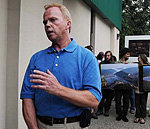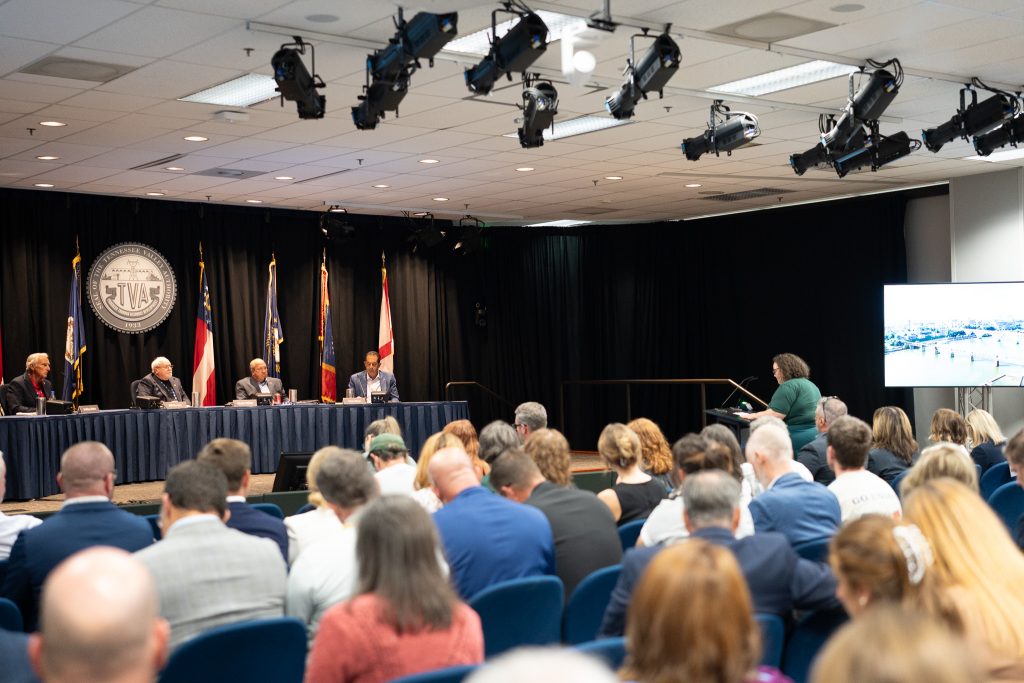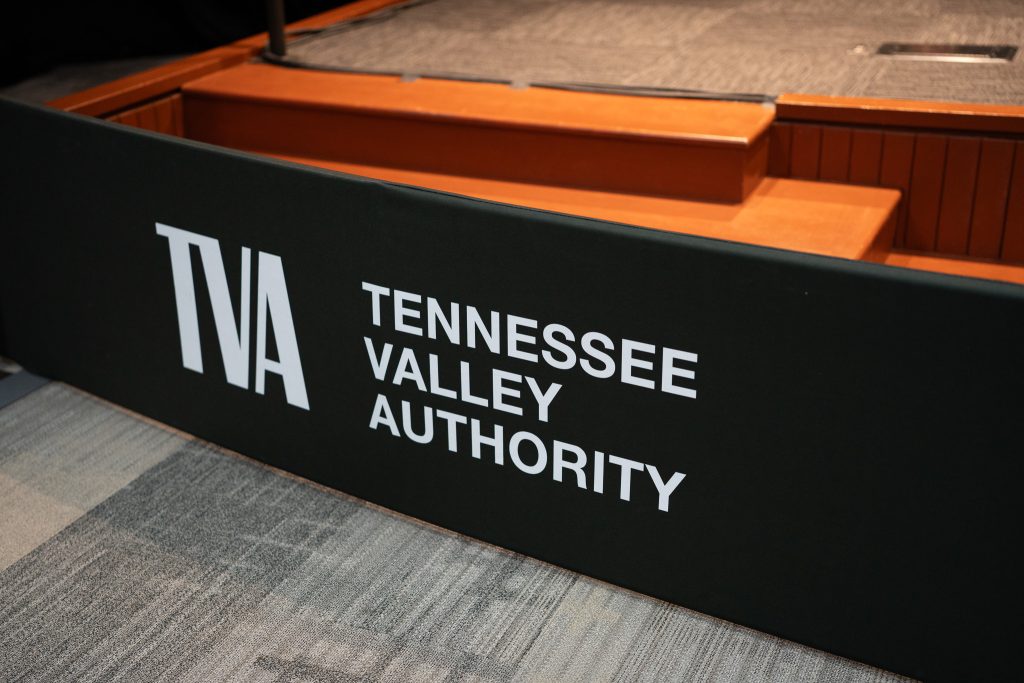Remembering Buffalo Creek
By Brian Sewell

Inspecting the Aftermath: Residents of Buffalo creek worried constantly about the stability of the slurry dams upstream. Photo courtesy of West Virginia State Archives.
In the morning of Feb. 26, 1972, nearly 132 million gallons of water and coal waste rushed from Buffalo Mining Company’s slurry impoundments through Buffalo Creek Hollow, Logan County, W.Va. The flood coursed through 16 coal mining settlements along the creek where hundreds of families lived, while children slept or watched cartoons as their mothers cooked breakfast. In an instant their lives were washed away.
The company men of Buffalo Mining’s owner, Pittston Coal Company, called it an “act of God.”
“People were in shock,” says Marty Backus, who was the news manager at WVOW Logan. “They just wanted to find their loved ones, find safety and find shelter.”
Backus navigated the floodwater to Man, a town at the mouth of Buffalo Creek, after staying on-air for a round-the-clock flood watch. He remembers vividly walking up the valley toward the town of Saunders and the broken dams.
“The clouds were hanging low over the valley,” he says.” People were walking down the railroad tracks. It seemed like hundreds of them. It was very quiet. People weren’t talking at all.”
He saw familiar faces. When William “Tootie” Carter, the head football coach at Man High School, emerged from the fog, Backus ran up to him.
“I said ‘Tootie, how bad is it?’ He didn’t even acknowledge me.”
. . . . .
Before mined coal is transported to the market and used for electricity, it is sent to a preparation plant, commonly called “tipples.” There, the raw coal is washed of impurities, crushed and transported to market by rail. Impounded in slurry ponds and injected underground, the toxic waste left over, mostly rock and fine coal suspended in water, contains toxic heavy metals such as arsenic and mercury. Many surface coal waste impoundments are simply valleys dammed with coal refuse, dry slurry — the very material that is being impounded.
A series of three dams were built on the Middle Fork upstream from the Buffalo Mining Co. tipple in the 1950s and 60s as Logan County continued to grow as one of southern West Virginia’s prolific coal-producing counties. Dam No. 3, the largest, stood 60 feet above the pond and downstream dams below. When it gave way, the others collapsed instantly.
Rushing through Buffalo Creek hollow, the slurry carried with it semi-rotten trees, rocks and sediment. It ripped homes from their foundations and swept up cars and bridges until it finished three hours and 15 miles later at the Guyandotte River, destroying nearly everything in its path. When the physical chaos settled, out of a population of 5,000 people, 125 were killed, 1,121 injured, and more than 4,000 were left homeless.
Jack Spadaro was a 23-year-old engineer teaching at West Virginia University’s School of Mines when Governor Arch Moore formed a commission to investigate the causes of the Buffalo Creek flood. He was asked by the dean of the School of Mines and chair of the governor’s commission, Jay Hillary Kelley, to travel to Buffalo Creek and investigate the disaster. When Spadaro arrived weeks later, they were still pulling bodies from the mud.
“I had never seen anything like that in my life,” he says. “It gave me a mission. It gave me a purpose.” Spadaro’s purpose became the protection of miners and communities where their families live; his mission, to enforce the laws already in place, and write new ones where they were needed.
Spadaro began his investigation by interviewing survivors, Buffalo Mining employees, engineers and contractors, recording them on a reel-to-reel in the Man, W.Va. high school gymnasium — a building that acted as a makeshift morgue and a gathering place for families of the missing. He dug through the records of the West Virgina Department of Natural Resources and Public Services Commission, the Bureau of Mines, and the U.S. Geological Survey. Before long, he began to uncover a pattern of shortcuts and regulators asleep at the wheel.

After the disaster. residents had few places to go - the flood had destroyed nearly everything in the path. Photo courtesy of West Virginia State Archives.
“All along, as these dams were being built, they weren’t really constructed using any engineering methods,” Spadaro says. “They were simply dumped, filled across the valley.”
The state’s Public Services Commission, responsible for dams blocking streams, required detailed plans for any structure over 15 feet high that obstructed a waterway. In the case of dams above Buffalo Creek, no plans were submitted.
“They just ignored the law.” says Spadaro. “But the Public Service Commission and the prosecutor in Logan County decided that since the dam was already built, they couldn’t do anything about it.”
Steve Dasovich, the vice president of Buffalo Mining, later admitted that during the construction of Dam No. 3, no engineering calculations were made and no outside soil experts’ or hydrologists’ services were solicited. Hours before the dam broke, it was Dasovich that who repeatedly told residents they were safe.
Still, some good came after the flood. By 1973, Spadaro had joined the Department of Natural Resources and began building an inventory of dams and enforcing new laws regulating coal waste and dam construction.
“We found about 150 unsafe coal waste dams in the state and forced the mining companies to stabilize them, build emergency spillways, put instruments in the dams that could monitor movement and bring everything up to the standards that were established in the laws,” he says.
Spadaro is certain that through preventative measures and strong enforcement, thousands of lives were saved. But even though the laws are on the books, a culture of corruption, non-compliance and the rejection of alternative technologies have led to more breaks, spills, and the necessity for advocacy groups who work to protect citizens. Forty years later, there are still lessons to learn from Buffalo Creek.
“It really did a lot of good and most of the state agencies and federal agencies were staffed with competent geotechnical engineers and hydrologists,” he says. “That is not the case now.”
Past Practice and a Culture of Corruption
On Oct. 11, 2000 it happened again. Around midnight, a portion of the reservoir basin of the Martin County Coal Corporation’s Big Branch impoundment near Inez, Ky. collapsed, inundating two tributaries of the Tug Fork with 306 million gallons of sludge. The EPA called it the worse [environmental] disaster in the southeastern United States, but luckily, this time no one was killed.
Martin County Coal, a subsidiary of Massey Energy, was quick to dismiss fault. Taking a page from the Pittston playbook, the company declared God had a hand in the massive spill. But when Mickey McCoy, a retired high school English teacher and longtime Martin County resident, stepped onto the soupy sludge that came into his community, he recognized it as an act of man. “That was one time you didn’t have to be Jesus Christ to walk on water,” he says.
Within days of the flood, Davitt McAteer, the head of MSHA during the Clinton administration, called someone he knew would not pull any punches. Jack Spadaro, who had become the superintendent at MSHA’s Mine Health and Safety Academy near Beckley, W.Va., joined team leader Tony Oppegard in Kentucky to launch an investigation into what went wrong.
Unlike Buffalo Creek, the 2-billion-gallon capacity, 70-acre slurry pond in Martin County suffered a breakthrough in the reservoir holding the slurry, not a dam failure. Almost two miles of active and abandoned underground mines beneath the basin were flooded out before the torrent of sludge blasted out of a mine opening and poured into Coldwater Creek. What connects the disasters are the patterns of neglect that were discovered too late.
According to Spadaro, by the time reservoir failure occurred, three agencies were responsible in the state of Kentucky: the state’s Division of Mine Reclamation and Enforcement, the Federal Office of Surface Mining and the Federal Mine Health and Safety Administration.
“Those agencies knew that that failure had occurred and they knew that there was a minimal amount of rock between the reservoir and those mine workings,” he says.
After a similar event at the same impoundment in 1994, Larry Wilson, an engineer at MSHA’s Technical Support Center in Pittsburgh, wrote a memo to the agency’s district office in Pikeville, Ky. with nine recommendations toward fixing flaws in the impoundment, including the revelation that as little as 15 feet of earth held up the reservoir, a fraction of the recommended 150 feet.
“They just completely ignored the recommendations,” says Spadaro. “All the managers in the various levels of these bureaucracies were simply not doing their jobs.”
In late 1994, Martin County Coal was granted a permit to expand the impoundment.
Once the heavy machinery moved in and recovery began, representatives from EPA region 4 held hearings in Inez to address residents’ concerns. McCoy remembers an auditorium full of students being told that the sludge, and their drinking water, is safe because everything it contains is on the periodic table of the elements. “It’s true,” the EPA representative reportedly said. “Go ask your biology teacher.”
McCoy’s wife, Nina, has taught biology at the school for 29 years.
“People have their buttons,” McCoy says. “That was her button. That was the bomb for her and then we started looking into everything about the mining industry.”
The University of Kentucky Markey Cancer Center in Lexington has expressed alarm at the high cancer rates in Martin County, and many others in Kentucky’s 5th congressional district. “There’s something about this region that we think is environmental causing this very high incidence,” the center’s director Dr. Mark Evers says. Markey Center research mentions the adverse effects of heavy metals such as arsenic and chromium in the water and soil and pointed out that counties with the highest levels of heavy metals are more likely to use well water.
“We all know the Markey Cancer Center,” says Nina McCoy. “I mean, it’s the University of Kentucky, who we think is a god here. So why don’t people here know that the Markey Cancer Center says that the cancer rate in this community is higher than anywhere else? Anybody that’s paying attention just buys their water because there is nothing else we feel like we can do.”
“Water is one of the best sellers at the supermarket here,” Mickey mentions.
Waking Up To the Toxic World We’ve Created

When the Brushy Fork impoundment reaches its permitted capacity, 9 billion gallons of slurry will be held in the 645-acre reservoir. Photo courtesy of Vivian Stockman
Of the hundreds of impoundments in Appalachia, several deemed high-hazard or Class “C” by MSHA — a classification given to dams whose failure would likely result in the loss of life — have been subjected to public condemnation and the grassroots efforts of citizens’ who refuse to forfeit their safety.
In West Virginia’s Coal River Valley is one of the largest dams of any kind on earth. The Brushy Fork dam, at 954 feet tall, looms over the towns of Sylvester and Whitesville in Raleigh County, W.Va. Around 645 acres, the impoundment will eventually hold 9 billion gallons of slurry. For activists, outside observers and residents in downstream communities, Brushy Fork has become a symbol of an industry out of control.
Over it’s lifetime, Brushy Fork’s size and rap sheet of violations have grown. Between 2000 and 2009, the impoundment received 20 violations. Some of them, especially issues related to dam compaction could, if left unabated, be fatal to downstream communities.

Forty years after the Buffalo Creek disaster, Jack Spadaro still works to improve mine safety and oversight. Photo courtesy of Vivian Stockman
In December 2011, largely in response to the perseverance of a retired union miner named Joe Stanley bombarding the administration with complaints about the impoundment, MSHA held a public meeting to address Brushy Fork. Over several hours, MSHA addressed a variety of complaints from poor communication between agencies to the stability of the mine workings beneath the impoundment and blasting at a surface mine only 100 yards away, with the conclusion that they believe the dam is safe.
Through a Freedom of Information Act request, Stanley specifically requested evidence or paperwork that proved that those citations were properly abated. Except for one citation, none was provided.
“We’re holding MSHA liable,” Stanley adds. “If there is any way that we can get a lawyer, to take this and sue, for the devaluation of those people’s property downstream, the health hazards that water is releasing and the destruction to their mental well-being by having to live underneath that thing, we intend to get to the bottom of it in any way possible.
Rob Goodwin, coordinator of the Citizens’ Enforcement Project for the Whitesville-based Coal River Mountain Watch, sees the meeting with MSHA as a step forward on a long road.
“The regulatory structure is just not capable of dealing with 100 or 50 more years of producing slurry,” says Goodwin. “It would just be way, way simpler to use other technologies.”
A Future of (Less) Slurry
“Not only was I an underground coal miner,” says Joe Stanley. “I was transferred as a filter-press operator at Maribone Development’s prep plant, which was absolutely the most advanced technology in the United States by a long shot in 1981.”
In a dry filter press system, water is pumped through a filtration fabric leaving the fine coal, clay and heavy metals in a “cookie” with little moisture left behind.

Joe Stanley is challenging coal companies to adopt safer technologies. Photo courtesy of the Charleston Gazette
Directly after Buffalo Creek, Stanley says, it was impossible to get a permit for an impoundment. The plant operated from 1979 to 1987 with no impoundment and no underground injection using filter presses and a closed loop water system.
“We could have continued to operate using those,” says Stanley. “But the company was able to get an impoundment permit and they felt they were at a financial disadvantage as a company because it was costing them somewhere in between 25 and 50 cents a ton to use filter presses.”
Spadaro encountered the same argument when he interviewed Martin County Coal CEO, Ray Bradbury after the Martin County flood. “They had a dry filter press but they stopped using it,” he says. “We asked Mr. Bradbury ‘Why did you stop using it and go to an impoundment? He said ‘We saved a dollar a ton in cost on processing.’”
A prep plant on a closed loop system can use less than 10 gallons of water per ton of coal. An open loop plant that pumps to an impoundment, uses between 65 and 70 gallons per ton.
Recently, Stanley has put his knowledge of filter presses and alternative coal waste disposal toward convincing legislators to move away from slurry.
“I’m not anti-coal,” he says. “But I do not believe in the impoundments because I know for a fact, from being a young man, that I have seen that technology applied and I’ve seen it work and if the state or federal government had the courage, we would not even have these impoundments at the present time.”
In the final pages of the report on the Buffalo Creek disaster, investigators concluded that Dam No. 3 on the Middle Fork was born out of the age-old practice in the coalfields of disposing of waste material and that it was constructed without utilizing technology developed for earthen dams and without consulting professionals qualified to design and build such a structure. In their search for answers, they failed to find any evidence of an act of God.
Related Articles
Latest News
More Stories

Leave a comment
Your email address will not be published. Required fields are marked *
4 responses to “Remembering Buffalo Creek”
-
This terrible Flood happen on My sister in Law Beulah Doty’s Birthday ,Her husband Alfred my brother had just came out of the mine when the Dam broke he said it looked like an atomic bomb When he walked down the side of the mountain To when his Home in Lundale was it was all gone his two son’s and wife had gone up the side of the mountain standing and watching there Home destroy also two cars .My brother Max Doty was a Deputy Sheriff he tried to warn the people to get up and go for safety.He Own the Doty’s Shake N Burger in Kistler He helped my Mom & Dad up the Hill in Kistler to safety they lost their dog Susie .Their home was damaged but more Blessed then so many .Then so very sad my dad Ernest H Doty Sr March 2 ,6 days after the flood had a heart attack and passed away I Pray something this bad never happens to the wonderful people and family there in W.va most of my family have already gone on to be with the Lord as of this date Mom ,Dad my 4 brothers & 2 sisters .4/22/23
-
Are Spadaro’s reel-to-reel interviews something that someone could upload and memorialize here?
-
Thanks very much Peter. It was a privilege to research this importart historical event and again ask, ‘have we learned our lesson?’
– Brian
-
First-class story. Shows a lot of work and a lot of understanding.





Leave a Comment